The Meizu PRO 5 Review
by Matt Humrick on June 24, 2016 8:00 AM EST- Posted in
- Smartphones
- Exynos
- Mobile
- Meizu
- Exynos 7420
System Performance
The Meizu PRO 5’s internal hardware is very similar to the Samsung Galaxy S6’s—Exynos 7420 SoC, LPDDR4 1552MHz RAM, UFS 2.0 NAND—so it’s not unreasonable to expect a similar level of performance. When the PRO 5 and Galaxy S6 launched in 2015, the Exynos 7420 was the SoC to beat, offering better performance and efficiency thanks in part to being the first to use Samsung’s FinFET process. The Exynos 7420 has since been eclipsed by a new generation of SoCs, but it still delivers solid performance.
Smartphones are about more than just performance, of course. Battery life is paramount and is ultimately what makes a mobile device mobile. To help its users strike the right balance between these two opposing metrics, Meizu’s Flyme OS offers three different power modes: Saving, Balance, and Performance. The Saving mode shuts down the four higher-performing but higher-power Cortex-A57 CPU cores, effectively giving the PRO 5 a quad-core Cortex-A53 CPU running at up to 1.5GHz, and is meant to prolong battery life at the expense of performance. The Balance mode, like its name suggests, tries to strike an equal balance between battery life and performance by disabling two A57 cores and capping the max frequency of the remaining two at 1.8GHz. The four A53 cores are still available at their max frequency of 1.5GHz. The Performance mode allows all eight CPU cores to run at their max rated frequencies simultaneously if needed.
To measure the impact of this strategy, we tested the PRO 5 in both its Performance and Balance modes. Results for both are shown in the charts on the next few pages.
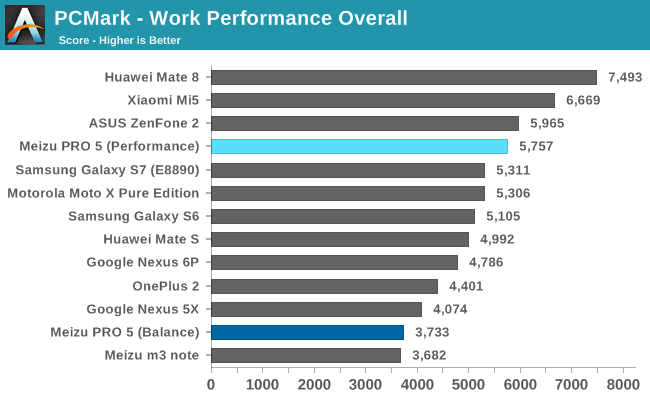
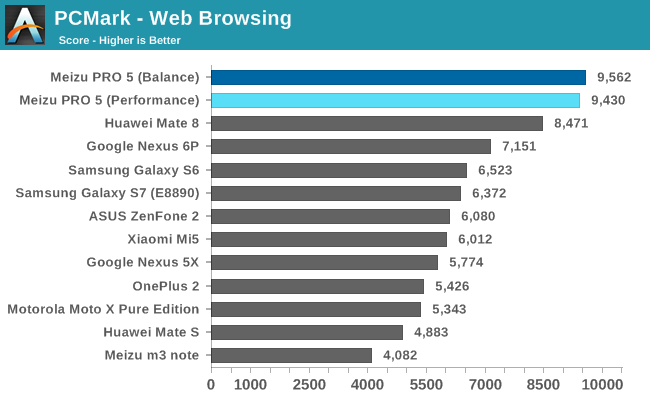
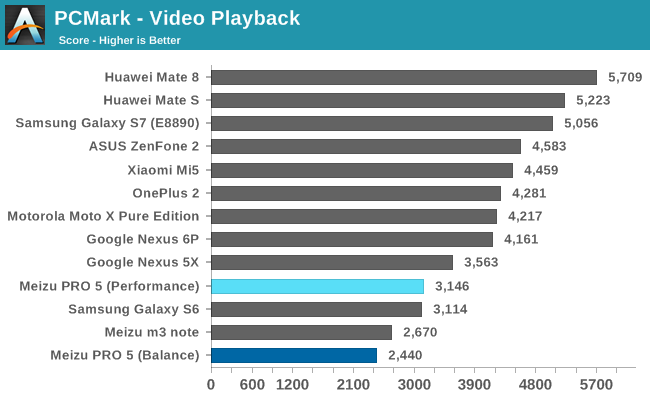
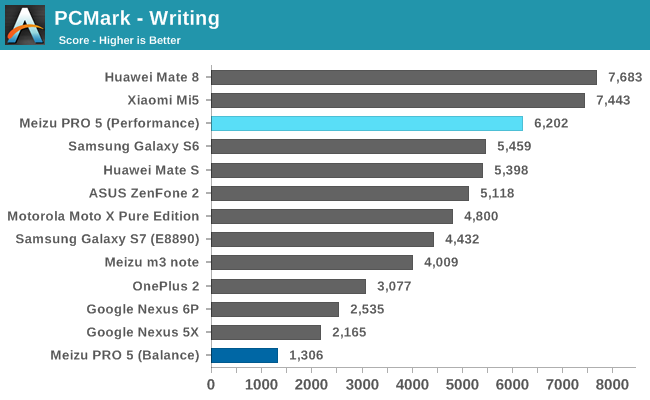
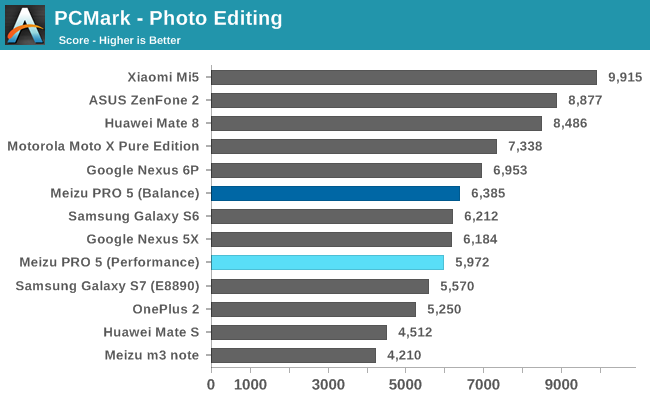
PCMark’s real-world workloads evaluate overall system performance by exercising the CPU, RAM, and NAND storage. Instead of pegging the CPU cores at their max frequency like synthetic benchmarks, PCMark elicits more realistic behavior from the CPU governor, making it a good indicator of how other apps that we use every day will perform.
Looking first at the overall score, the PRO 5 does well, outperforming even newer flagships like the Galaxy S7. We also see a significant difference between the PRO 5’s Performance and Balance modes, with the former providing a 54% boost. However, overall scores can often be misleading.
Diving into the individual tests, the PRO 5 seems to deliver exceptional performance in Web Browsing with no discernable difference between the two power modes. Video Playback is similar to the Galaxy S6 in Performance mode, which holds a 29% advantage over Balance mode, although neither device using the Exynos 7420 does particularly well in this test. The PRO 5, like the S6, performs well in the Writing test, well, at least sometimes.
The PRO 5 produces erratic results in both the Video Playback and Writing tests when using the Performance mode. Around half the time it delivers results similar to those in the charts above. The other times, however, the PRO 5 shuts down the A57 cores completely and idles the A53 cores at 400MHz for the duration of these two tests, resulting in horrible scores. This appears to be a bug with Meizu’s DVFS implementation. The good news is that I was not able to reproduce this scenario while running several different apps from Meizu, Google, and third-parties, so this appears to be limited to PCMark. Without more comprehensive testing there’s no guarantee that some app or workload will not trigger this behavior, however. Using Balance mode could be a workaround, because it did not suffer from this issue.

We recently added DiscoMark to our test suite as part of our effort to better capture real-world performance. You can find a good explanation of how this test works and how we are using it in our LG G5 review, but basically this test measures application launch times by using Android's accessibility services to monitor an application’s startActivity() method, which starts the process of building the app’s UI elements.
The PRO 5 opens apps from internal storage very quickly, noticeably faster than the Nexus 5X and Nexus 6P, and essentially equal to even the latest flagship phones. Switching to Balance mode slows performance by 31%, but it still feels very fast.
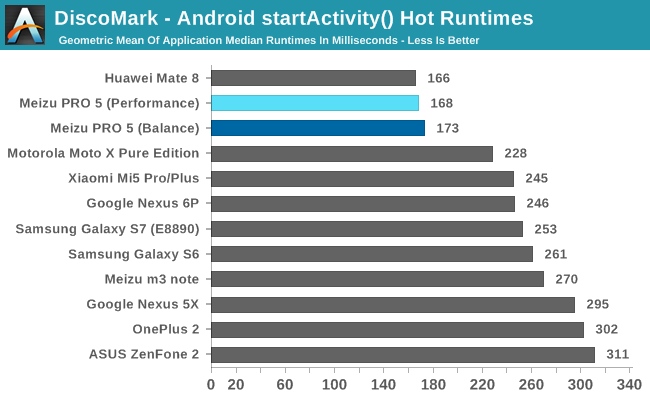
The PRO 5 is also very fast when switching between apps that are already loaded in RAM, with no penalty when using Balance mode. It equals the performance of Huawei’s Mate 8 and P9 and holds a 25% to 35% advantage over the other phones in the chart going back to the Galaxy S6.
Taken together, PCMark and DiscoMark show the PRO 5 performs very well with common, everyday tasks, which agrees with my personal experience while using the phone. The UI is fluid, the keyboard responds as quickly as I can move my thumbs, and scrolling through image-heavy web pages is smooth.

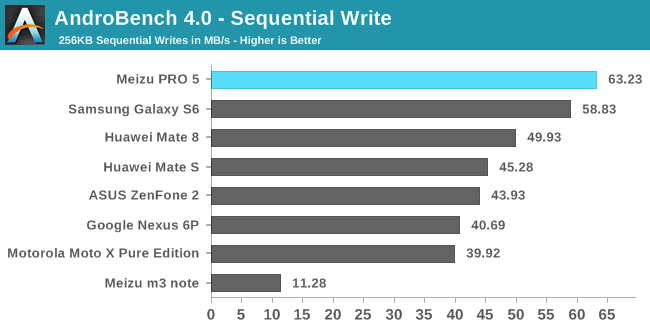
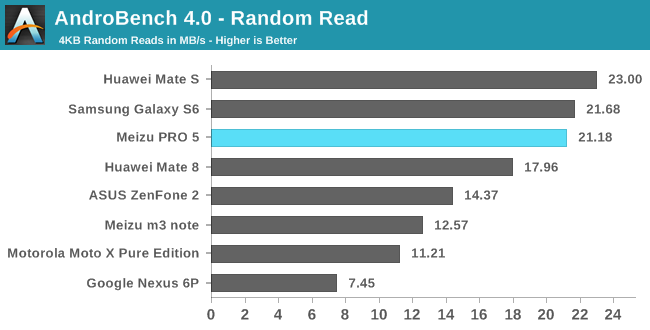
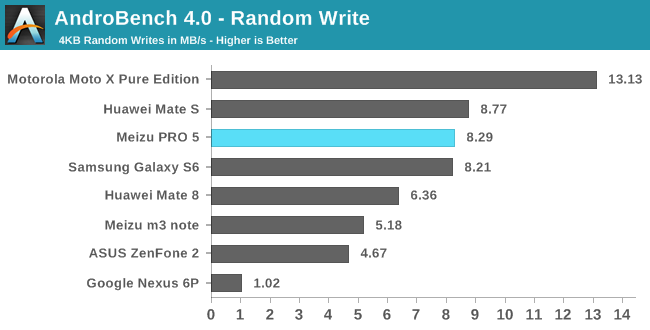
In our internal storage test, the PRO 5 posts very good results across the board, part of the reason why it does so well with launching applications. It’s not surprising that we see the PRO 5 and Galaxy S6 post near identical speeds, because both are using the same UFS 2.0 controller that’s built into the Exynos 7420 SoC and the same KLUBG4G1BD-E0B1 NAND with a maximum queue depth of 16.
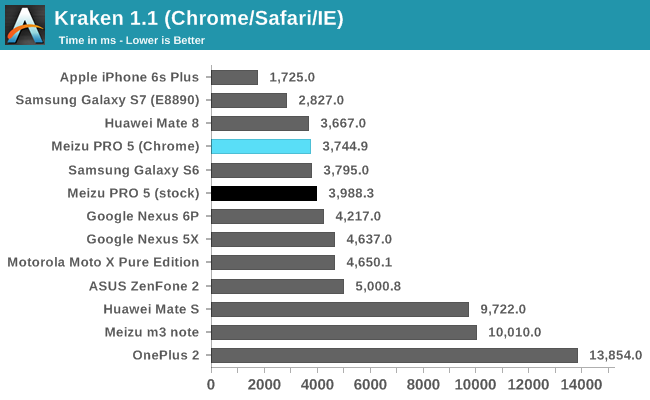
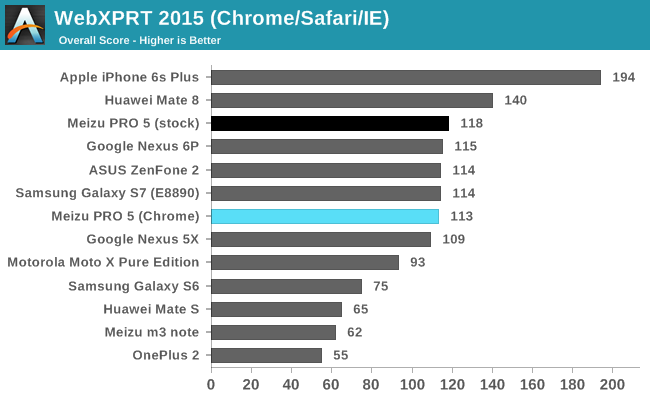

Chrome is the default browser in our web-based JavaScript tests, but we’re also including the results from Meizu’s stock browser for comparison. Unfortunately, it does not provide any better performance than Chrome.
The PRO 5 performs as good or better than the phones with previous generation SoCs. It lands near the top of the chart in Kraken and is around 20% slower than the Mate 8 and its Kirin 950 SoC in JetStream and WebXPRT.
Despite launching at the end of 2015, the PRO 5 still feels plenty fast and compares well to current generation flagship phones. While there is a performance penalty when using the Balance mode to conserve power, it’s generally not severe and not even noticeable in most cases.


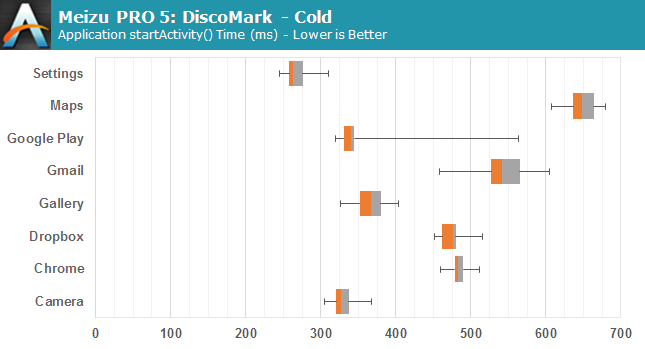









80 Comments
View All Comments
Matt Humrick - Friday, June 24, 2016 - link
A few reasons:1) AnandTech has a global audience and we're trying to be more inclusive.
2) The Chinese OEMs are becoming increasingly relevant. Huawei is the third largest smartphone company by volume, for example.
3) Not all of the Chinese phones are bad.
4) Coincidence. Between a bevy of new device announcements and new relationships with companies, we received a windfall of devices from Chinese OEMs this spring. Also, some of our reviews are behind schedule (you may have noticed :), which jumbles the publishing order.
Will you continue to see reviews of devices from China? Yes. But we're not going to forget our readers in the US.
LiverpoolFC5903 - Tuesday, July 5, 2016 - link
Meizu is one of the best Chinese odms out there, with impeccable build quality and nice little innovations like the multifunctional home button that recognizes a tap as well as is mechanically click able.Love the fact that AT is doing more reviews of Chinese phones. Quite a few of Europeans are starting to import directly from China.
The beloved iPhone is also fully manufactured in China as well so readers would do well not to raise non existent quality issues.
justaway2 - Friday, June 24, 2016 - link
What's the point of reviewing phones that doesn't support North American LTE bands properly? This is a North American review site, after all. Band 7 and 38 are sparingly used in some spots in Canada, and 41 is only used on Sprint in the US. The rest are useless in NA.LTE band 1(2100), 3(1800), 7(2600), 38(2600), 39(1900), 40(2300), 41(2500)
It really bothers me how essentially no reviews ever talk about LTE band support.
BrokenCrayons - Friday, June 24, 2016 - link
This might be a surprise, but there are a lot of people on the planet that don't live in North America.justaway2 - Friday, June 24, 2016 - link
Is Anandtech not a North America-based site catering to a North American readership?There's 1.4B people living in China. Why isn't Anandtech publishing articles in Chinese?
Impulses - Friday, June 24, 2016 - link
I don't think the writers are all in NA, and they're all over the map so I dunno if you can say the site is l is based in any particular place anymore... I do remember reading requests for Chinese phone reviews for quite a while before they started doing them. I don't care one way or the other...BigLan - Friday, June 24, 2016 - link
It seems to be moving to more of a european site now rather than US based - most of the smartphone team is based in the UK iirc.Matt Humrick - Friday, June 24, 2016 - link
"What's the point of reviewing phones that doesn't support North American LTE bands properly?"See my answer above.
Speaking for myself (and I believe AnandTech in general), I always list band support for region specific devices. I usually will not for phones such as the iPhone or Samsung's Galaxy phones, because they are sold around the world and with all the different region/carrier models, band support is much less of an issue.
Andrei Frumusanu - Friday, June 24, 2016 - link
AnandTech is an English review site, not an North American one. NA readership accounts for less than half of total traffic.As the European mobile editor here I find such comments absolutely disappointing as such unfounded views are very much a core problem of why sometimes vendors are not willing to source devices as they see AT not as the "target market" even though we get plenty of comments requesting us to review these devices. And in the end, the last point is what matters, there absolutely is demand for us to review these devices and Chinese vendors are becoming more and more important both in terms of market-share but also in terms of innovation and product quality.
We will actually increase coverage of vendors such as Xiaomi or Meizu whose devices are focused on Asian markets because there is absolutely demand and interest in them.
more-or-less - Friday, June 24, 2016 - link
Just registered to say this - thank you :)We all wait for reviews of various brands as they are also getting popular across the globe. Those who don't want to read these reviews, they can easily read something else which they find interesting.